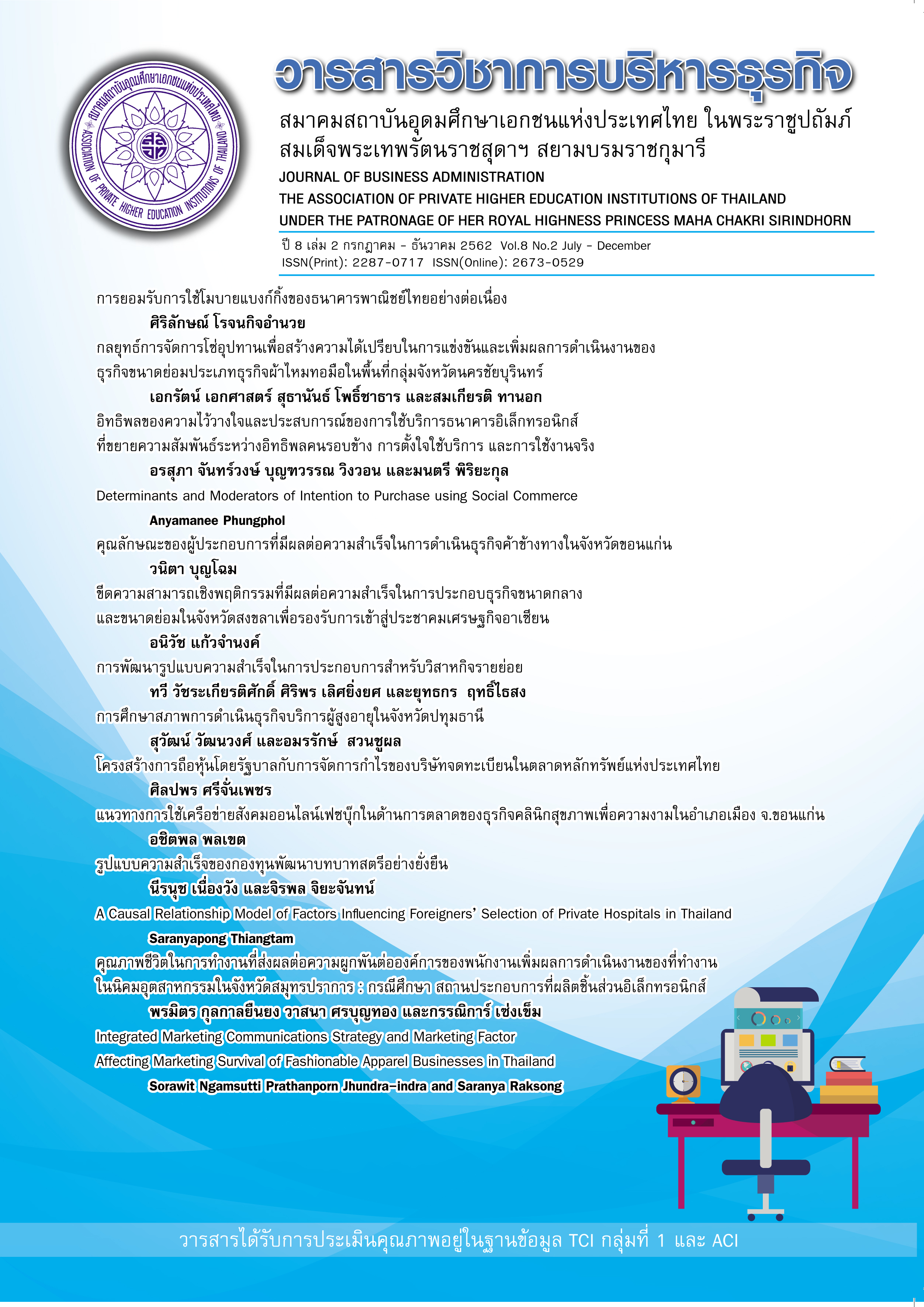กลยุทธ์การจัดการโซ่อุปทานเพื่อสร้างความได้เปรียบในการแข่งขันและ เพิ่มผลการดำเนินงานของธุรกิจขนาดย่อมประเภทธุรกิจผ้าไหมทอมือในพื้นที่ กลุ่มจังหวัดนครชัยบุรินทร์
คำสำคัญ:
การจัดการโซ่อุปทาน, ความได้เปรียบในการแข่งขัน, ผลการดำเนินงานของธุรกิจ, ธุรกิจขนาดย่อม, ผ้าไหมทอมือบทคัดย่อ
วัตถุประสงค์ของการวิจัย คือเพื่อศึกษาระดับความสำคัญของการจัดการโซ่อุปทานข้อได้เปรียบในการแข่งขัน
และผลการดำเนินงานของธุรกิจ เพื่อวิเคราะห์ความสัมพันธ์เชิงสาเหตุของปัจจัยที่มีอิทธิพลต่อผลการดดำเนินงานของ
ธุรกิจและเพื่อสร้างกลยุทธ์การจัดการโซ่อุปทานของธุรกิจขนาดย่อมประเภทธุรกิจผ้าไหมทอมือ เพื่อเพิ่มผลการดำเนิน
งานของธุรกิจ โดยมีพื้นที่เป้าหมาย คือกลุ่มจังหวัดนครชัยบุรินทร์ซึ่งใช้วิธีการวิจัย แบบผสมผสานโดยเก็บข้อมูลด้วย
แบบสอบถามจำนวน 500 คนและแบบสัมภาษณ์เชิงลึก จำนวน 12 คน สำหรับการวิเคราะห์ข้อมูลแบ่งเป็น
การวิเคราะห์ด้วยสถิติเชิงพรรณนาสมการเชิงโครงสร้าง และเนื้อหาผลการศึกษา พบว่าผู้ประกอบการให้ความสำคัญกับ
การจัดการโซ่อุปทานไปด้านหลังข้อได้เปรียบในการแข่งขันด้านมุ่งเฉพาะกลุ่มและผลการดำเนินงานของธุรกิจ
ด้านกระบวนการบริหารภายในธุรกิจมากที่สุดด้านแบบจำลองมีความสอดคล้องกับข้อมูลเชิงประจักษ์โดยมีค่า
CMIN/df = 1.659, CFI=0.988, GFI=0.937, AGFI=0.920,NFI=0.971, IFI=0.988, RMR=0.018 และ RMSEA=0.036
แสดงว่าตัวแปรในสมการโครงสร้างมีความสามารถในการพยากรณ์ได้ดีและเป็นที่ยอมรับได้ และด้านกลยุทธ์ แบ่งเป็น
3 ส่วน คือกลยุทธ์การบูรณาการโซ่อุปทานไปด้านหลังกับโซ่อุปทานภายในธุรกิจ กลยุทธ์การบูรณาการการจัดการ
โซ่อุปทานภายในธุรกิจ และกลยุทธ์การบูรณาการโซ่อุปทานไปด้านหน้ากับโซ่อุปทานภายในธุรกิจโดยการใช้กลยุทธ์
การจัดการโซ่อุปทานข้างต้นทำให้เกิดความได้เปรียบในการแข่งขันและเพิ่มผลการดำเนินงานของธุรกิจ
เอกสารอ้างอิง
Agyapong, A., Ellis, F., & Domeher, D. (2016). Competitive strategy and performance of family businesses: moderating effect of managerial and innovative capabilities. Journal of Small Business and Entrepreneurship, 28(6), 449-477.
Baudino, C., Giuggioli, N. R., Briano, R., Massaglia, S., & Peano, C. (2017). Integrated methodologies (SWOT, TOWS, LCA) for improving production chains and environmental sustainability of kiwifruit and baby kiwi in Italy. Sustainability, 9 (1), 1-18.
Best, J.W., & Kahn, J.V. (2014). Research in Education (8th ed.). New York: Allyn and Bacon.
Brian, D. (2015). Distinguishing Earth, Water, Fire, and Air: Factor Analysis to Determine the Four Fundamental Elements of State Capability. Boston: Harvard Business School Press.
Brown, T. A. (2015). Confirmatory Factor Analysis for Applied Research. (2nd ed.) New York: Guilford.
Chen, I.J., & Paulraj, A. (2004). Understanding supply chain management: critical research and a theoretical framework. International Journal of Production Research, 42 (1), 131-163.
Chopra, S., & Meindl, P. (2010). Supply Chain Management :Strategy, Planning and Operation. New Jersey: Pearson Prentice Hall.
Christos, S.T., Konstantinos, G.Z., & Alan, H. (2014). Developing a conceptual model for examining the supply chain relationships between behavioural antecedents of collaboration, integration and performance. The International Journal of Logistics Management, 25 (3),418-462.
Gaskin, J. E. (2014). Partial least squares (PLS) structural equation modeling (SEM) for building and testing behavioral causal theory : when to choose it and how to use It. IEEE Transactions on Professional Communication, 57(2), 123-146.
Grades, E. (2014). Structural Equation Modelling with Latent Variables. German: Heinrich-Heine-University.
Hair, J.F., Hult, G.T., Ringle, C.M., & Sarstedt, M. A. (2017). Primer on Partial Least Squares Structural Equation Modeling (PLS-SEM). Washington DC: Prentice Hall.
Huo, B., Qi, Y., Wang, Z., & Zhao, X. (2014). The impact of supply chain integration on firm performance : the moderating role of competitive strategy. Supply Chain Management :An International Journal, 19(4), 369-384.
Johnston, M., Dixon, D., Hart, J., Glidewell, L., Schröder, C., & Pollard, B. (2014). Content validity: a quantitative methodology for assessing content of theory-based measures, with illustrative applications. Journal of Health Psychology, 15 (3), 240-257.
Kaplan, R.S., & Norton, D.P. (1996). The Balanced Scorecard :Translating Strategy into Action. Boston:Harvard Business School Press.
Karami, A., Sahebalzamani, S., & Sarabi, B. (2015) The influence of HR practices on business strategy and firm performance: the case of banking industry in Iran. The IUP Journal of Management Research, 15 (1), 30-53.
Kline, R. B. (2016). Principles and Practice of Structural Equation Modeling (4th ed.). New York: The Guilford Press.
Nawaz, M., & Bhatti, G. A. (2018). The content analysis of the strategic management studies in the last 15-years: 2001-2016. International Journal of Information, Business and Management,10 (1), 246-254.
Özdemir, Ai., Simonetti, B., & Jannell, R. (2015). Determining critical success factors related to the effect of supply chain integration and competition capabilities on business performance. Quality & Quantity, 49(4), 1621–1632.
Oyewobi, L.O., Windapo, A.O., & James, R.B. (2015). An empirical analysis of construction organization competitive strategies and performance. Built Environment Project and Asset Management, 5 (4), 417-431.
Pallant, J. (2016). SPSS Survival Manual: A Step By Step Guide to Data Analysis Using SPSS Program (6th ed.). London, UK: McGraw-Hill Education.
Porter, M.E. (1980). Competitive Strategy. Boston: Harvard Business Review.
Provincial Community Development Office of Buriram. (2016). Silk Trader Statistics. Buriram: Provincial Community Development Office of Buriram.
Provincial Community Development Office of Chaiyaphum. (2016). Silk Trader Statistics. Chaiyaphum: Provincial Community Development Office of Chaiyaphum.
Provincial Community Development Office of Nakhon Ratchasima. (2016). Silk Trader Statistics. Nakhon Ratchasima: Provincial Community Development Office of Nakhon Ratchasima.
Provincial Community Development Office of Surin. (2016). Silk Trader Statistics. Surin: Provincial Community Development Office of Surin.
Stephen, S., & Molly, F. (2014). Validity Evidence based on Test Content. Psicothema, 26 (1), 100-107.
The Office of SMEs Promotion. (2018). SME Situation Report 2018. Bangkok: The Office of SMEs Promotion (OSMEP).
The Office of Strategy Management, Lower Northeast 1. (2017). Development Plan for the Lower Northeast Province Group 1, 4 Years Period (2018 - 2021). Nakhon Ratchasima: (Copied).
Todd, F.L. (2017). Evidence regarding the internal structure: confirmatory factor analysis. Measurement and Evaluation in Counseling and Development, 50 (4), 239-247.
Xu, D., Huo, B., & Sun, L. (2014). Relationships between Intra-organizational Resources, Supply Chain Integration and Business Performance : An Extended Resource-based View. Industrial Management & Data Systems, 114 (8), 1,186-1,206.
Zhao, L., Huo, B., Sun, L., & Zhao, X. (2013). The Impact of supply chain risk on supply chain integration and company performance: A global investigation. Supply Chain Management : An International Journal, 18 (2),115-131.

ดาวน์โหลด
เผยแพร่แล้ว
รูปแบบการอ้างอิง
ฉบับ
ประเภทบทความ
สัญญาอนุญาต
บทความที่ลงตีพิมพ์ในวารสารวิชาการบริหารธุรกิจ สมาคมสถาบันอุดมศึกษาเอกชนแห่งประเทศไทยต้องเป็นบทความที่ไม่เคยได้รับการตีพิมพ์เผยแพร่ หรืออยู่ระหว่างการพิจารณาตีพิมพ์ในวารสารอื่นๆ การละเมิดลิขสิทธิ์เป็นความรับผิดชอบของผู้ส่งบทความโดยตรง

